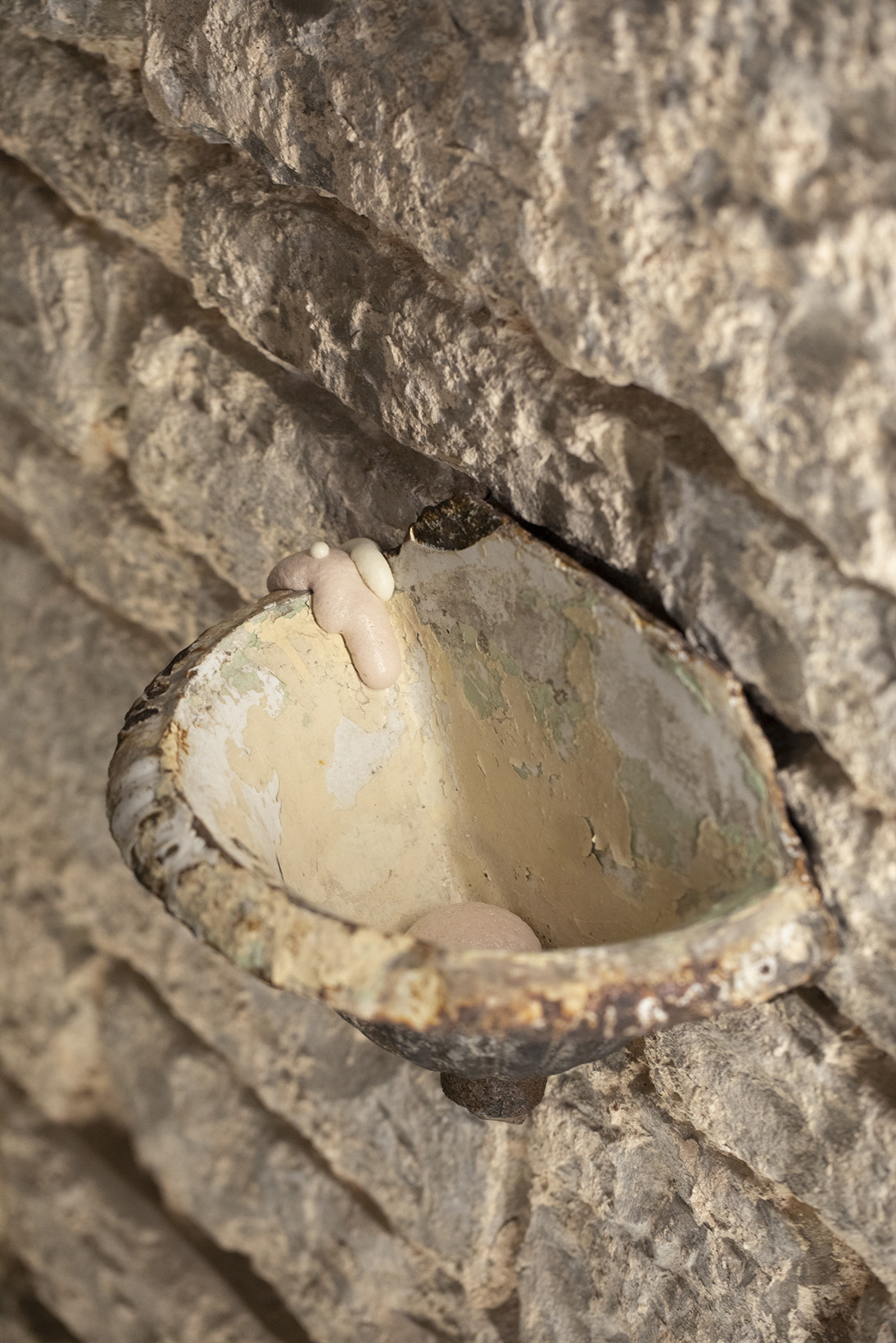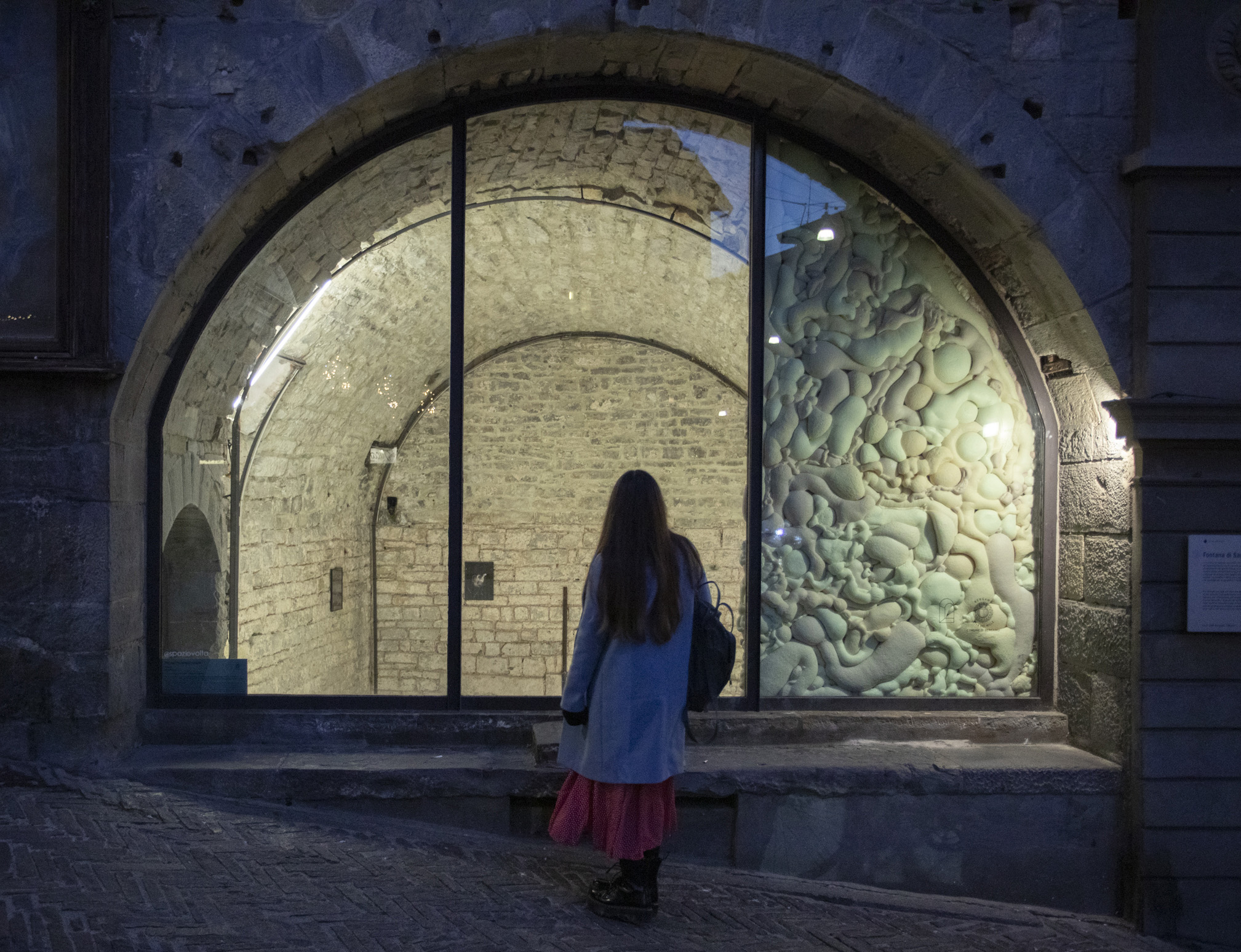
MIA DUDEK FILLERS

Fillers, Mia Dudek (Poland, 1989) solo show
Curated by Edoardo De Cobelli and Federico Castoldi
Text by Orsola Vannocci Bonsi
Introducing the Humid Feminine
In 1948 Eugenio Montale wrote a mesmerizing, voluptuous and sinuous poem, “l’Anguilla” (the eel), which guides the fortunate reader, or listener, through the arduous path of the animal, the journey undertaken to reproduce, to continue Life, as a metaphor of the sweet, sensual and lively resistance of the feminine. The eel slips through the mud, the ooze, a slimy and humid dimension to find its fulfillment, in its exquisitely feminine struggle, following its vital instinct.
Humidity is the same leitmotif tying the pieces that Mia Dudek offers to this – “wombish” – space, a vault. Humidity as the ideal condition for the formation of mushrooms, their growth and proliferation, as the ones portrayed in the series “Fruiting Bodies”: organisms that, as the eel, creep, slip, enter, being extremely fertile and prolific. Dudek caught these entities as something erotic and inviting, yet simple, as with a sensually sweet glance at these beings, their sprouting is destructive, they could damage what they inhabit, but at the same time they are bringers of life. The same destructive force is metaphorized by the polyurethane foam, with its change of state – from liquid, therefore creeping and penetrating, to solid, thus large, occupying, spacious – taking place in the site-specific intervention “Stroke V”. Here, the foam seizes the window of the space, defeating it, as a fungus, a prolific parasitic animal which started to grow on it, occupying part of it but still leaving a space to be able to see what happens inside. Somehow uncomfortable, yet inviting – thanks perhaps also to the candyish reassuring color and visual consistency of the foam – there is a way to peek inside, a peekaboo as a revealer to a somehow private, domestic dimension. The domesticity is indeed found in the bathtub located in the space, the private, intimate place par excellence and obviously wet and humid, which inevitably impregnates the room with childhood memories and maternal warmth. “Bath” is like a cocoon, but at the same time a lieu of wonder, as if someone just left this domestic scene to expand her/himself elsewhere, leaving silicon traces of their passages on the floor – “Skinscapes”.
The force expressed by Mia Dudek’s works is devastating and at the same time gentle and maternal, delicate, but active and resistant, interconnected – like the spores of a mushroom. The artist therefore transcends the sacred idea of a possible domestic divine feminine, which is already in itself opposed to the patriarchal concept of sacredness. Instead of being high and revered hers is much more linked to the earthly soil, moving and growing from below, like the spilled silicon, genderless like the mushrooms, even closer to a terrestrial carnality, like Montale’s eel. A feminine which for sure is indeed divine, but not sublimated, rather real and tangible and above all tactile: Humid.
Testo di Orsola Vannocci Bonsi
Introducendo l’Umido Femminile
Nel 1948 Eugenio Montale scrisse una poesia ipnotica, voluttuosa e sinuosa, “l’Anguilla”, che guida il fortunato lettore, o ascoltatore, attraverso l’arduo percorso dell’animale, il viaggio intrapreso per riprodursi, per continuare la Vita, come metafora della dolce, sensuale e viva resistenza della femminilità. L’anguilla scivola nel fango, nella melma, in una dimensione viscida e umida per trovare il suo compimento, nella sua lotta squisitamente femminile, seguendo il suo istinto vitale.
L’umidità è lo stesso leitmotiv che lega le opere che Mia Dudek offre a questo spazio “uterino”, una volta a botte. Umidità come condizione ideale per la formazione dei funghi, la loro crescita, la loro proliferazione, come quelli ritratti nella serie “Fruiting Bodies”: organismi che, come l’anguilla, strisciano, scivolano, entrano, essendo estremamente fertili e prolifici. La Dudek ha colto queste entità come qualcosa di erotico e invitante ma allo stesso tempo semplice, come con uno sguardo sensualmente dolce rivolto a questi esseri. Il loro germogliare è distruttivo, potendo danneggiare ciò che abitano, ma allo stesso tempo portatore di vita. La stessa forza distruttiva è metaforizzata dalla schiuma poliuretanica, con il suo cambiamento di stato – da liquido, strisciante e penetrante, a solido, grande, voluminoso, spazioso – che avviene nell’intervento site-specific “Stroke V”. Qui, la schiuma si impadronisce della finestra dello spazio, sconfiggendola, come un fungo, un prolifico animale parassita che ha iniziato a crescervi sopra, occupandone una parte ma lasciando comunque uno spazio per poter vedere cosa succede all’interno. In un certo senso scomodo, eppure invitante – grazie forse anche al caramelloso colore rassicurante e alla consistenza visiva della schiuma – c’è un modo per sbirciare dentro, una finestra che apre su di una dimensione privata, domestica. Domesticità che ritroviamo nella vasca da bagno collocata nello spazio, il luogo privato, intimo per eccellenza e ovviamente umido e bagnato, che inevitabilmente impregna la stanza di ricordi d’infanzia e calore mater- no. “Bath” è un bozzolo, ma allo stesso tempo un luogo di meraviglia, come se qualcuno avesse appena lasciato questa scena domestica per espandersi altrove, lasciando tracce di silicone dei suoi passaggi sul pavimento – “Skinscapes”.
La forza espressa dalle opere di Mia Dudek è devastante e allo stesso tempo gentile e materna, delicata, ma attiva e resistente, interconnessa – come le spore di un fungo. L’artista trascende quindi l’idea sacra di un possibile divino femminile domestico, che già di per sé si oppone al concetto patriarcale di sacralità. Invece di essere alto e venerato il suo è molto più legato alla terra, si muove e cresce dal basso, come il silicio versato, senza genere come i funghi, ancora più vicino a una carnalità terrestre, come l’anguilla di Montale. Un femminile sicuramente divino, ma non sublimato, piuttosto reale e tangibile e soprattutto tattile: Umido.

Text by Federico Castoldi
In Ancient Greece the Earth was described in two different ways corresponding to two differing dimensions: the first was Chtonia and the second, still used today, was Gaia. Chtonia referred to the Earth below the surface, while Gaia referred to the Earth above the surface.
Chtonia was the abyss, the world of the spirit, the dead, the secret; a world that can only show itself through its superficial side, Gaia. Gaia was the hill, the green, the walkable: the fruit, the excrescence. Metaphorically, if the earth were a fungal formation, Chtonia would be the mycelium and Gaia its fungus.
Since the beginning of modernity, there has been a progressive distancing from the Cht- onic dimension of life. Agamben says: “life is more lovable the more tenderly it preserves within itself the memory of Chtonia”. But where can we look for this today? It is a matter of opening a gap – a cthon – an opening that can relate the present with the past, the deep with the superficial.
The Spazio Volta Project finds its identity in this tension, between the underground of the cistern and the glass wall on the surface. Mia Dudek’s works, in conversation with the former San Rocco’s fountain, converses with its cracks, its fractures, becoming their excrescence that makes its memory resurface, invading its most hidden corners.
Mia’s works investigate the duly guarded memory, the perpetuation of history that re-emerges in the present. Her fruits are symptomatic of a profound, inner relationship, of a series of processes that manifest themselves through silicone and polyurethane foam, recurring elements of the practice as well as rust, a bathtub and a 19th century tap. By recreating an evocative environment of organic and inorganic presences, Mia is giving form to the formless which now appears on cast iron and stone.
“I pini connettono i punti sotto l’asfalto nascondono un’idea sotto trenta centimetri d’aghi”
Nella Grecia antica la terra veniva apostrofata in due modi diversi, corrispondenti a due sue dimensioni, la prima era Chtonia e l’altra, ancora usata ad oggi, era Gaia. Con Chtonia ci si riferiva alla terra dalla superficie in giù, mentre con Gaia ci si riferiva alla terra dalla superficie in su. Chtonia era l’abisso, il mondo dello spirito, dei morti, del segreto. Un mondo che non poteva mostrarsi se non nella sua facciata superficiale, Gaia. Gaia era la collina, il suo verde, il calpestabile: è il frutto, l’escrescenza. Per intenderci con una meta- fora tutt’altro che casuale, se la terra fosse una formazione fungina, Chtonia sarebbe il micelio e Gaia il suo fungo.
Se dall’inizio della modernità in poi c’è stata un progressivo allontanamento dalla dimensione Chtonica della vita, Agamben si pronuncia così: “la vita è tanto più amabile tanto più teneramente custodisce in sé la memoria di Chtonia”. Ma dove possiamo noi oggi cercare questa coesione? Si tratta di aprire un varco, cthon – un’apertura che possa mettere in relazione il presente con il passato, il profondo con il superficiale.
Spazio Volta trova la sua identità in questa tensione, tra il sottosuolo della cisterna e la vetrata in superficie. Le opere di Mia Dudek, in conversazione con l’ex fontana di San Rocco, dialogano così con le sue spaccature, le sue fratture, diventando loro l’escrescenza che ne fa riaffiorare la memoria, in un fruttificare che ne invade gli angoli più nascosti. I lavori di Mia indagano la memoria debitamente custodita, la perpetuazione della storia che nel presente riemerge. I suoi frutti sono sintomatici di una relazione profonda, interiore, d’una serie di processi che si manifestano attraverso il silicone e il poliuretano espanso, elementi ricorrenti della pratica, ma anche la ruggine, una vasca, un rubinetto del XIX secolo. Mia, ricreando un ambiente evocativo di presenze organiche e inorganiche, riesce a dar forma all’informe, che oggi si palesa sulla ghisa e sulla pietra.




